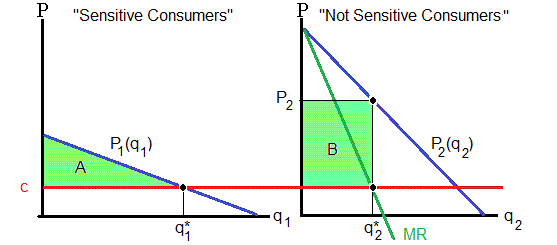|
1. Firms sell consumers products for different prices;
-
Why?
-
A firm captures consumers' surplus, enhancing revenue and profits
-
A firm captures market share
-
A firm undermines competition or force competition out of market
-
Example - Standard Oil reduced its price for petroluem products below competitors in one small town
-
The competitors went out of business
-
Standard Oil bought the competitors' assets for cents on the dollar and raised prices to earn monopoly profits
-
Standard Oil entered into another town
-
Techniques
-
Market Segmentation – consumers can be separated by markets
-
Two-part pricing – company charges two fees
-
Fixed fee: flat fee paid upfront; hookup charge
-
Variable charge: companies charge per usage; rate charge
-
T(q) = A + P q
-
Example: Common for utility companies
-
Gas
-
Telephone
-
Electricity
-
Tying and bundling – producer sells one product that is required for another product
-
Quality discrimination – seller sells similar products that differ in quality
2. Conditions for Price Discrimination
-
Company needs some monopoly power to influence market price
-
A “mechanism” to separate customers into different groups
-
Prevent re-sale: Consumer who pays for product for a low price re-sells the product to another consumer who pays a higher price
|
|
1. First Degree Price Discrimination – monopolist can extract all surplus from customers
-
Demand function – customers can be ranked by their reservation price
-
Reservation price – consumer’s willingness to pay
-
Reservation price (V i)
-
Monopolist needs perfect information about customers

-
Result
-
Monopolist’s profits = consumers' surplus + producers' surplus
-
The last customer pays a reservation price, P i = MC
-
Discriminating monopolist ensures customers are satisfied in terms of quality, etc.

-
Monopolist sets P = MC = 10
-
Consumers' surplus = 0.5 (100 – 10)(90 – 0) = 4,050
-
Monopolist charges the price T(Q) = 4,050 + 10 Q

-
Company introduces new product and charges price, P 1
-
After some time, the company lowers the price to P 2
-
After more time, the company lowers the price to P 3
-
Monopolist stops lowering the price, when P i = MC(Q)
-
Company will develop a new product to repeat the process
-
Coase stated
-
If consumers are sufficiently patient, then consumers could wait for monopoly to drop prices
-
Have a competitive equilibrium
2. Second Degree Price Discrimination

-
Monopolist has marginal cost, MC(q 1 + q 2) = c
-
Monopolist charges the sensitive consumer
-
Monopolist charges monopoly prices by MR = MC to the “not sensitive consumers”
-
Total profits = A + B
3. Third Degree Price Discrimination
-
Monopolist has information about consumers
-
Monopolist can separate consumers into groups
-
Two demand functions, P 1(q 1) and P 2(q 2)
-
Profit maximization, MR 1(q 1) = MR 2(q 2) = MC(q 1 + q 2)
-
If MC(q 1 + q 2) = c
-
Monopolist charges sensitive consumers P 1 and not sensitive consumers P 2
-
Not allocative efficient, P 2 > P 1 > MC

|



